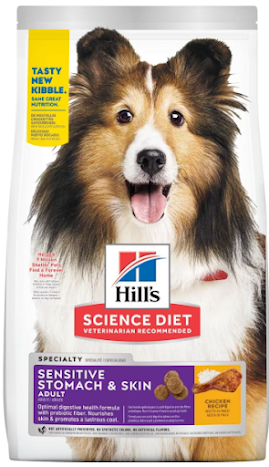What is intestinal barrier dysfunction?
The intestinal tract normally acts as a selective barrier:
it permits nutrient absorption while preventing harmful substances (toxins,
microbes, undigested food) from entering the bloodstream. When this barrier is
compromised, increased permeability (the “leaky gut” phenomenon) may allow
undue passage of luminal contents, provoking immune-activation and inflammation
in the body.
In veterinary medicine, the precise term “leaky gut
syndrome” is not a formal diagnosis for dogs, but the concept (intestinal
hyper-permeability) is increasingly being studied and considered in connection
with gastrointestinal and systemic disease.
Evidence of barrier dysfunction in dogs
One study compared dogs with Atopic dermatitis (a skin‐allergy
condition) to healthy dogs, and found elevated biomarkers (intestinal alkaline
phosphatase [IAP] and trefoil factor-3 [TFF-3]) consistent with intestinal
epithelial damage in the atopic dogs. The authors suggest that intestinal
damage may predispose to allergen ingress and subsequent skin disease. Another study in dogs with chronic gastrointestinal disease
(intestinal lymphangiectasia) found increased serum/fecal markers such as
zonulin (a regulator of tight junctions) and bacterial lipopolysaccharide (LPS)
which suggest compromised barrier integrity.
More broadly, reviews of intestinal barrier structure and
permeability across species highlight that microbiota, diet, inflammation,
stress, and tight junction regulation all influence barrier health. While not
dog‐specific
in all cases, these concepts apply to canine physiology as well.
What factors appear to contribute?
Microbiome imbalance (dysbiosis): Changes in gut flora
correlate with barrier impairment. For dogs, probiotic studies show improved
epithelial barrier function and reduced inflammation in some GI conditions.
Diet & allergens: Food allergens and certain dietary
components may stress the gut barrier. In dogs with atopic dermatitis, the
possibility that allergens entering through a damaged gut lining may contribute
to skin disease was raised.
Inflammation / GI disease: Chronic intestinal inflammation
(e.g., from infection, immune‐mediated enteropathy) is likely to
impair barrier function; studies in dogs with GI disease support this.
Other stressors: Physical stress, ischemia, toxins,
medications (NSAIDs) and ageing have been implicated in barrier dysfunction in
other species. These findings suggest similar mechanisms may apply in dogs.
What do we know about treatment/support?
Probiotic supplementation in dogs has been shown to enhance
expression of tight‐junction proteins in intestinal tissue, reduce
diarrhea, modulate microbiota diversity and reduce inflammation in GI
conditions.
Nutritional/functional medicine approaches emphasise a
“five-R” protocol: Remove (stressors/allergens), Replace (digestive supports),
Re-inoculate (pro/prebiotics), Repair (nutrients for gut lining), Rebalance
(diet, lifestyle). These are applied in pet‐specific contexts.
Veterinary sources indicate treating potential underlying
causes (food allergy, medication‐induced damage, infection),
switching to hypo-allergenic or highly digestible diets, and avoiding damaging
medications (where possible) as part of “gut
barrier” care.
Key take-aways
- While “leaky gut” remains a non-specific term and not a
formal diagnosis in dogs, there is growing evidence that compromised intestinal
barrier integrity plays a role in certain canine diseases (skin allergies,
chronic GI disorders) and may amplify systemic inflammation.
- Diagnosis is challenging: there is no single “leaky gut”
test in dogs. Rather, barrier dysfunction is inferred via biomarkers (IAP,
TFF-3, zonulin), histology or functional permeability tests (in research
settings) plus clinical context.
- Management is best approached holistically: addressing diet,
microbiome, inflammation, and lifestyle/stress factors. Probiotics and diet
support appear promising but require more targeted research in dogs.
- Clients should be cautioned about over-promising quick
“fixes”. Barrier repair is likely gradual and dependent on underlying cause.
The veterinary team should guide diagnostics and interventions rather than rely
solely on “gut healing” buzzwords.
Gaps & future directions
More canine‐specific, controlled studies are
needed: e.g., quantifying permeability in dogs, linking barrier biomarkers to
outcome, validating therapeutic protocols.
Standardised measurement techniques for intestinal
permeability in dogs (non‐invasive, reliable) remain
limited.
The interplay between diet (especially novel
proteins/processed food), microbiota shifts, and barrier integrity in dogs is
an active area for research.
Longitudinal studies to determine whether barrier repair
correlates with improved clinical outcomes (skin disease, GI disease, systemic
inflammation) in dogs.
Conclusion
The concept of intestinal barrier dysfunction—the “leaky
gut” idea—is increasingly relevant in canine medicine. While the research is
still emerging, it offers a useful framework for understanding how GI health,
immune activation and systemic disease may intersect in dogs. Veterinary
professionals should treat barrier support as one component of an integrated
treatment plan: diagnosing underlying causes, implementing diet/microbiome
strategies, and monitoring clinical response.
References
Ekici, Y. E., & Ok, M. (2024). Investigation of the
relationship between atopic dermatitis of dogs and intestinal epithelial
damage. Veterinary Medicine and Science, 10(3), e1453.
https://doi.org/10.1002/vms3.1453
Stewart, A. S., Pratt-Phillips, S., & Gonzalez, L. M.
(2019). Alterations in intestinal permeability: The role of the “leaky gut” in
health and disease. Animals, 9(6), 209. https://doi.org/10.3390/ani9060209
Sanders, M. E., et al. (2023). Gut probiotics and health of
dogs and cats: Benefits, applications and future directions. Animals, 13(2),
350. https://doi.org/10.3390/ani13020350
Weir, M., & Barnette, C. (n.d.). Leaky gut syndrome in
dogs. VCA Animal Hospitals. Retrieved from
https://vcahospitals.com/know-your-pet/leaky-gut-syndrome-in-dogs/




Comments
Post a Comment